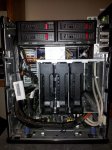Sn00zE
Cadet
- Joined
- Jan 17, 2013
- Messages
- 5
Hi guys,
I have build myself a NAS box. Have a HP Microserver with some mods to it. Freenas will be running of USB flash from internal USB.
The Microserver has the standard 4x 3.5" bays in the front, added a raid card to pci-e and a Vantec MRK-425ST EZ-Swap F4 Mobile Rack 4x 2.5" SATA6G in the 5.25" Rom bay, also have a cable running from the esata to internally for 1 more extra drive behind the Rom bay.
I am planning to add the following:
4x 3.5" SATA 2TB drives (3TB if i get them cheap) - in the front bays
4x 2.5" SATA 1TB drives in the Vantec EZ-Swap bays
1x 2.5" SATA 1TB (could be a 2TB also) behind the Vantec EZ-Swap bay
Now my question is how to configure the pool setup or manage the disks the best way? Anyone got some ideas?
I have build myself a NAS box. Have a HP Microserver with some mods to it. Freenas will be running of USB flash from internal USB.
The Microserver has the standard 4x 3.5" bays in the front, added a raid card to pci-e and a Vantec MRK-425ST EZ-Swap F4 Mobile Rack 4x 2.5" SATA6G in the 5.25" Rom bay, also have a cable running from the esata to internally for 1 more extra drive behind the Rom bay.
I am planning to add the following:
4x 3.5" SATA 2TB drives (3TB if i get them cheap) - in the front bays
4x 2.5" SATA 1TB drives in the Vantec EZ-Swap bays
1x 2.5" SATA 1TB (could be a 2TB also) behind the Vantec EZ-Swap bay
Now my question is how to configure the pool setup or manage the disks the best way? Anyone got some ideas?

